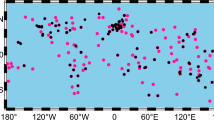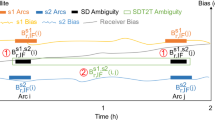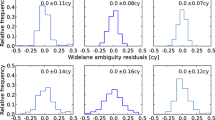Abstract
The formation-flying technique is a fundamental concept for earth observing satellite missions, which usually require both absolute and relative orbit accuracies. Their precise orbit determinations are usually exclusively performed based on spaceborne GNSS data, where integer ambiguity resolution (IAR) plays a crucial role in achieving the best orbit accuracy. However, it is found that single-receiver IAR by resolving the single-difference (SD) ambiguities between GNSS satellites at each individual formation-flying satellite cannot achieve the same relative orbit accuracy that is attained by double-difference (DD) IAR between formation-flying satellites. To unravel this problem, 1 year of GPS data collected by the Gravity Recovery and Climate Experiment (GRACE) mission are used and four types of orbits are derived for comparison: (1) orbits where no ambiguities are fixed; (2) orbits where SD IAR is performed for both satellites; (3) orbits where only DD ambiguities between the twin GRACE satellites are resolved; (4) and orbits where SD IAR is carried out on only GRACE A while DD IAR is further accomplished between the twin satellites, namely the integrated SD IAR and DD IAR solutions. They are then evaluated through comparison to the reduced-dynamic orbit generated at the Jet Propulsion Laboratory, residual analysis of satellite laser ranging (SLR), and K-Band ranging (KBR) measurements. As expected, the integrated SD IAR and DD IAR solutions can achieve the highest absolute and relative orbit accuracies simultaneously. Specifically, SLR residuals in case of the integrated IAR are reduced by at least 25% for the kinematic orbit, when compared to the case of DD IAR. KBR residuals in case of the integrated IAR are reduced by 35 and 16% for the dynamic and kinematic orbit, respectively, when compared to those of SD IAR. Importantly, we find that errors in GPS clocks and/or narrow-lane fractional-cycle biases are in part responsible for the deteriorated relative accuracy of SD IAR achieved orbits. Therefore, we suggest that the integrated SD IAR and DD IAR scheme should be implemented for the best orbit solutions of formation-flying missions.





Similar content being viewed by others
References
Allende-Alba G, Montenbruck O (2016) Robust and precise baseline determination of distributed spacecraft in LEO. Adv Space Res 57(1):46–63. https://doi.org/10.1016/j.asr.2015.09.034
Allende-Alba G, Montenbruck O, Jäggi A, Arnold D, Zangerl F (2017) Reduced-dynamic and kinematic baseline determination for the swarm mission. GPS Solutions 21(3):1275–1284. https://doi.org/10.1007/s10291-017-0611-z
Allende-Alba G, Montenbruck O, Hackel S, Tossaint M (2018) Relative positioning of formation-flying spacecraft using single-receiver GPS carrier phase ambiguity fixing. GPS Solutions 22(3):68. https://doi.org/10.1007/s10291-018-0734-x
Arnold D, Montenbruck O, Hackel S, Sośnica K (2018a) Satellite laser ranging to low earth orbiters: orbit and network validation. J Geodesy. https://doi.org/10.1007/s00190-018-1140-4
Arnold D, Schaer S, Villiger A, Dach R, Jäggi A (2018b) Undifference ambiguity resolution for GPS-based precise orbit determination of low Earth orbiters using the new CODE clock and phase bias products. International GNSS Service Workshop 2018, Wuhan, China, 29 October–2 November, 2018
Berger C, Biancale R, Ill M, Barlier F (1998) Improvement of the empirical thermospheric model DTM: DTM94—a comparative review of various temporal variations and prospects in space geodesy applications. J Geodesy 72(3):161–178. https://doi.org/10.1007/s001900050158
Bertiger W, Desai SD, Haines B, Harvey N, Moore AW, Owen S, Weiss JP (2010) Single receiver phase ambiguity resolution with GPS data. J Geodesy 84(5):327–337. https://doi.org/10.1007/s00190-010-0371-9
Bettadpur S (2012) GRACE product specification document. CSR-GR-03-02, v4.6. Center for Space Research, University of Texas at Austin
Blewitt G (1989) Carrier phase ambiguity resolution for the global positioning system applied to geodetic baselines up to 2000 km. J Geophys Res Solid Earth 94(B8):10187–10203. https://doi.org/10.1029/Jb094ib08p10187
Bock H, Dach R, Jäggi A, Beutler G (2009) High-rate GPS clock corrections from CODE: support of 1 Hz applications. J Geodesy 83(11):1083–1094. https://doi.org/10.1007/s00190-009-0326-1
Case K, Kruizinga G, Wu S-C (2010) GRACE level 1B data product user handbook. JPL D-22027, v1.3. Jet Propulsion Laboratory
Collins P (2008) Isolating and estimating undifferenced GPS integer ambiguities. In: Proceedings of ION NTM 2008, Institute of Navigation, San Diego, California, USA, 28–30 January, pp 720–732
Desai SD (2002) Observing the pole tide with satellite altimetry. J Geophys Res 107(C11):7-1-7-13. https://doi.org/10.1029/2001jc001224
Dong DN, Bock Y (1989) Global positioning system network analysis with phase ambiguity resolution applied to crustal deformation studies in California. J Geophys Res Solid Earth 94(B4):3949–3966. https://doi.org/10.1029/Jb094ib04p03949
Dunn C et al (2003) Instrument of GRACE. GPS World 14(2):17–28
Flechtner F, Dobslaw H, Fagiolini E (2015) AOD1B product description document for product release 05. GR-GFZ-AOD-0001. GFZ German Research Centre for Geosciences
Folkner WM, Williams JG, Boggs DH (2009) The planetary and lunar ephemeris DE 421. Jet Propulsion Laboratory, California Institute of Technology
Förste C, Bruinsma SL, Abrikosov O, Lemoine J-M, Marty JC, Flechtner F, Balmino G, Barthelmes F, Biancale R (2014) EIGEN-6C4 the latest combined global gravity field model including GOCE data up to degree and order 2190 of GFZ Potsdam and GRGS Toulouse. Geophysical Research Abstracts, EGU2014-3707. EGU General Assembly, Vienna, Austria, 27 April–2 May, 2014
Friis-Christensen E, Lühr H, Knudsen D, Haagmans R (2008) Swarm—an earth observation mission investigating geospace. Adv Space Res 41(1):210–216. https://doi.org/10.1016/j.asr.2006.10.008
Ge M, Gendt G, Dick G, Zhang FP (2005) Improving carrier-phase ambiguity resolution in global GPS network solutions. J Geodesy 79(1–3):103–110. https://doi.org/10.1007/s00190-005-0447-0
Ge M, Gendt G, Rothacher M, Shi C, Liu J (2008) Resolution of GPS carrier-phase ambiguities in precise point positioning (PPP) with daily observations. J Geodesy 82(7):389–399. https://doi.org/10.1007/s00190-007-0187-4
Geng J, Bock Y (2016) GLONASS fractional-cycle bias estimation across inhomogeneous receivers for PPP ambiguity resolution. J Geodesy 90(4):379–396. https://doi.org/10.1007/s00190-015-0879-0
Geng J, Teferle FN, Meng X, Dodson AH (2011) Towards PPP-RTK: ambiguity resolution in real-time precise point positioning. Adv Space Res 47(10):1664–1673. https://doi.org/10.1016/j.asr.2010.03.030
Geng J, Chen X, Pan Y, Zhao Q (2019) A modified phase clock/bias model to improve PPP ambiguity resolution at Wuhan University. J Geodesy. https://doi.org/10.1007/s00190-019-01301-6
Gu DF, Ju B, Liu JH, Tu J (2017) Enhanced GPS-based GRACE baseline determination by using a new strategy for ambiguity resolution and relative phase center variation corrections. Acta Astronaut 138:176–184. https://doi.org/10.1016/j.actaastro.2017.05.022
Guo X, Zhao Q, Ditmar P, Sun Y, Liu J (2018) Improvements in the monthly gravity field solutions through modeling the colored noise in the GRACE data. J Geophys Res Solid Earth 123(8):7040–7054. https://doi.org/10.1029/2018JB015601
Hatch R (1982) The synergism of GPS Code and carrier measurements. IN: Proceedings of the third international symposium on satellite doppler positioning, Physical Sciences Laboratory of New Mexico State University, 8–12 February, pp 1213–1231
Jäggi A, Hugentobler U, Bock H, Beutler G (2007) Precise orbit determination for GRACE using undifferenced or doubly differenced GPS data. Adv Space Res 39(10):1612–1619. https://doi.org/10.1016/j.asr.2007.03.012
Jäggi A, Dach R, Montenbruck O, Hugentobler U, Bock H, Beutler G (2009) Phase center modeling for LEO GPS receiver antennas and its impact on precise orbit determination. J Geodesy 83(12):1145–1162. https://doi.org/10.1007/s00190-009-0333-2
Kouba J (2009) A guide to using International GNSS Service (IGS) products. ftp://www.igs.org/pub/resource/pubs/UsingIGSProductsVer21.pdf
Krieger G, Moreira A, Fiedler H, Hajnsek I, Werner M, Younis M, Zink M (2007) TanDEM-X: a satellite formation for high-resolution SAR interferometry. IEEE Trans Geosci Remote Sens 45(11):3317–3341. https://doi.org/10.1109/tgrs.2007.900693
Kroes R, Montenbruck O, Bertiger W, Visser P (2005) Precise GRACE baseline determination using GPS. GPS Solutions 9(1):21–31. https://doi.org/10.1007/s10291-004-0123-5
Laurichesse D, Mercier F, Berthias JP, Bijac J (2008) Real time zero-difference ambiguities fixing and absolute RTK. In: Proceedings of ION NTM 2008, Institute of Navigation, San Diego, California, USA, 28–30 January, pp 747–755
Laurichesse D, Mercier F, Berthias JP, Broca P, Cerri L (2009) Integer ambiguity resolution on undifferenced GPS phase measurements and its application to PPP and satellite precise orbit determination. Navigation 56(2):135–149
Li P, Zhang X, Ren X, Zuo X, Pan Y (2015) Generating GPS satellite fractional cycle bias for ambiguity-fixed precise point positioning. GPS Solutions 20(4):771–782. https://doi.org/10.1007/s10291-015-0483-z
Liu J, Ge M (2003) PANDA software and its preliminary result of positioning and orbit determination. Wuhan Univ J Nat Sci 8(2):603–609
Loyer S, Perosanz F, Mercier F, Capdeville H, Marty J-C (2012) Zero-difference GPS ambiguity resolution at CNES–CLS IGS Analysis Center. J Geodesy 86(11):991–1003. https://doi.org/10.1007/s00190-012-0559-2
Mao X, Visser PNAM, van den Ijssel J (2017) Impact of GPS antenna phase center and code residual variation maps on orbit and baseline determination of GRACE. Adv Space Res 59(12):2987–3002. https://doi.org/10.1016/j.asr.2017.03.019
Marshall JA, Luthcke SB (1994) Modeling radiation forces acting on Topex/Poseidon for precision orbit determination. J Spacecr Rockets 31(1):99–105. https://doi.org/10.2514/3.26408
Melbourne WG (1985) The case for ranging in GPS-based geodetic systems. In: Proceedings of the first international symposium on precise positioning with the global positioning system, Rockville, 15–19 April, pp 373–386
Mendes VB, Pavlis EC (2004) High-accuracy zenith delay prediction at optical wavelengths. Geophys Res Lett. https://doi.org/10.1029/2004gl020308
Mendes VB, Prates G, Pavlis EC, Pavlis DE, Langley RB (2002) Improved mapping functions for atmospheric refraction correction in SLR. Geophys Res Lett 29(10):53-51-53-54. https://doi.org/10.1029/2001gl014394
Montenbruck O, Hackel S, Jäggi A (2017) Precise orbit determination of the Sentinel-3A altimetry satellite using ambiguity-fixed GPS carrier phase observations. J Geodesy 92(7):711–726. https://doi.org/10.1007/s00190-017-1090-2
Montenbruck O, Hackel S, van den Ijssel J, Arnold D (2018) Reduced dynamic and kinematic precise orbit determination for the swarm mission from 4 years of GPS tracking. GPS Solutions 22:79. https://doi.org/10.1007/s10291-018-0746-6
Pearlman MR, Degnan JJ, Bosworth JM (2002) The international laser ranging service. Adv Space Res 30(2):135–143. https://doi.org/10.1016/S0273-1177(02)00277-6
Petit G, Luzum B (2010) IERS Conventions (2010). IERS Technical Note No. 36. Verlag des Bundesamts für Kartographie und Geodäsie, Frankfurt am Main, Germany. http://www.iers.org/TN36/
Priestley KJ, Smith GL, Thomas S, Cooper D, Lee RB, Walikainen D, Hess P, Szewczyk ZP, Wilson R (2011) Radiometric performance of the CERES earth radiation budget climate record sensors on the eos aqua and terra spacecraft through April 2007. J Atmos Ocean Technol 28(1):3–21. https://doi.org/10.1175/2010jtecha1521.1
Rieser D, Mayer-Gürr T, Savcenko R, Bosch W, Wünsch J, Dahle C, Flechtner F (2012) The ocean tide model EOT11a in spherical harmonics representation. Institute of Theoretical Geodesy and Satellite Geodesy (ITSG), TU Graz, Austria; Deutsches Geodätisches Forschungsinstitut (DGFI), Munich, Germany; GFZ German Research Centre for Geosciences, Potsdam, Germany. https://www.tugraz.at/fileadmin/user_upload/Institute/IFG/satgeo/pdf/TN_EOT11a.pdf
Schmid R, Steigenberger P, Gendt G, Ge M, Rothacher M (2007) Generation of a consistent absolute phase-center correction model for GPS receiver and satellite antennas. J Geodesy 81(12):781–798. https://doi.org/10.1007/s00190-007-0148-y
Švehla D, Rothacher M (2005) Kinematic precise orbit determination for gravity field determination. In: Sansò F (ed) A window on the future of geodesy. International Association of Geodesy Symposia, vol 128. Springer. Berlin, Heidelberg, pp 181–188. https://doi.org/10.1007/3-540-27432-4_32
Tapley BD, Bettadpur S, Ries JC, Thompson PF, Watkins MM (2004) GRACE measurements of mass variability in the earth system. Science 305(5683):503–505. https://doi.org/10.1126/science.1099192
Wu JT, Wu SC, Hajj G, Bertiger WI, Lichten SM (1993) Effects of antenna orientation on GPS carrier phase. Manuscr Geod 18(2):91–98
Wübbena G (1985) Software developments for geodetic positioning with GPS using TI-4100 code and carrier measurements. In: Proceedings of the first international symposium on precise positioning with the global positioning system, Rockville, 15–18 April, pp 403–412
Acknowledgements
The work was sponsored by the National ‘863 Program’ of China (Grant No. 2014AA121501), the National Natural Science Foundation of China (Grant Nos. 41674033, 41574030, 41904009). The numerical calculations in this research have been done on the supercomputing system in the Supercomputing Center of Wuhan University. The FCB or phase bias products can be found at ftp://igs.gnsswhu.cn/pub/whu/phasebias/, and open-source PPP-AR software can be obtained from pride.whu.edu.cn.
Author information
Authors and Affiliations
Corresponding author
Additional information
Publisher's Note
Springer Nature remains neutral with regard to jurisdictional claims in published maps and institutional affiliations.
Rights and permissions
About this article
Cite this article
Guo, X., Geng, J., Chen, X. et al. Enhanced orbit determination for formation-flying satellites through integrated single- and double-difference GPS ambiguity resolution. GPS Solut 24, 14 (2020). https://doi.org/10.1007/s10291-019-0932-1
Received:
Accepted:
Published:
DOI: https://doi.org/10.1007/s10291-019-0932-1




